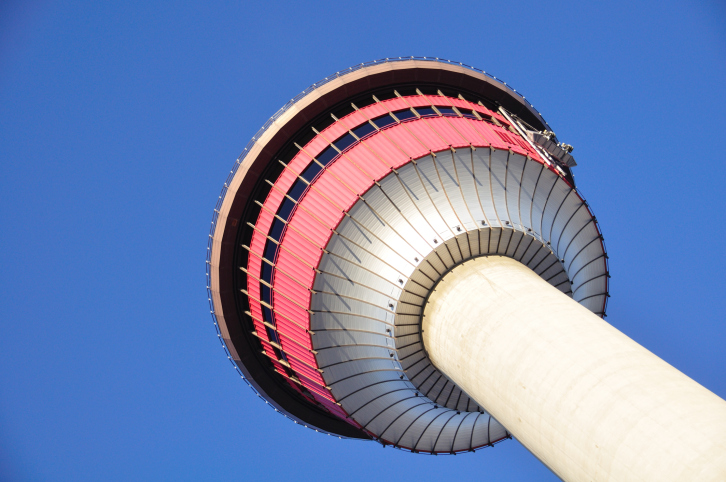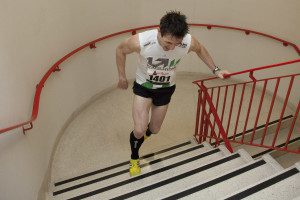Stair running: A gross grind

 In 1989, Brendan Keenoy set an unusual record. The police detective didn’t know what to expect when he found himself in the lead up the CN Tower Climb after a frenetic start. He heard the echoing steps of his lone challenger fade as he powered up the 1,776 stairs of the CN Tower’s emergency staircase, two at a time. His legs were flooded with lactic acid, and his eardrums began to tighten. “I realized after the second time they popped that it was because of the altitude.”
In 1989, Brendan Keenoy set an unusual record. The police detective didn’t know what to expect when he found himself in the lead up the CN Tower Climb after a frenetic start. He heard the echoing steps of his lone challenger fade as he powered up the 1,776 stairs of the CN Tower’s emergency staircase, two at a time. His legs were flooded with lactic acid, and his eardrums began to tighten. “I realized after the second time they popped that it was because of the altitude.”
Keenoy was relieved when he reached the observation deck, and not because he won. “There’s no air in there – it’s just a concrete box with no windows,” he says from his home in the west end of Toronto. “You go through these air pockets as you climb, where there doesn’t seem to be any oxygen,” Keenoy said. His ascent took just 7:52, making him the fastest person to run up the tallest free-standing structure in the Western hemisphere.
Keenoy’s incredible feat has remained untouched for 24 years, although he isn’t happy about it. Keenoy is the first to admit that he wasn’t a standout talent during his peak. “I ran a bunch of sub-three hour marathons. I wish someone, preferably a Canadian, would just come along and break it.” Heenoy might get his wish in the near future.
Tower running, as it’s now called, has grown from being a novelty to a legitimate subdivision of running in Europe and Southeast Asia. There is even a global circuit, the Vertical World Challenge, which hosts something similar to a road race, only up the stairwells of buildings such as the Empire State Building and Taipei 101.
VWC organizer Lauri van Houten decided to create the series after years of involvement in sky running, high-altitude trail races that evolved out of Europe’s centuries-old tradition of fell running and recording “fastest known times” on legendary routes.
“We selected eight to nine iconic buildings around the world,” van Houten says from Chamonix, France, on the eve of one of the Sky Running Federation’s signature events, the Mont-Blanc Marathon. “It’s very easy to get several hundred or even a few thousand runners for an event. In Taipei, we get 4,000 runners.”
The VWC attracts former elite runners, many of whom travel from continent to continent in order to amass points for the circuit championship. One of those runners is Suzy Walsham. The Australian found tower running after a career that culminated with the 2006 Commonwealth Games, when she competed in both the 800m and 1,500m.
“In some respects, tower running is the same as being on the track, particularly in terms of needing good lactic tolerance as well as endurance,” Walsham says from her home in Singapore. “But unlike a middle-distance track race, you are in a world of lactic pain for a lot longer and your strength and power is probably more important than speed.” A challenge in racing up a narrow stairwell is getting in position to pass another runner. Competitors will purposely hold both sides of the railing in order to block a pass. “Most runners are sporting and either step aside or let you run around them,” Walsham says of the etiquette involved in tower racing. “But once I got stuck behind a quite famous athlete who insisted on using both handrails. After five floors of yelling and screaming I ended up having to grab her left arm away from the handrail and passed her on the outside.”
 Most of the tower races on the 2013 VWC are time trials, with organized heats to avoid congestion. But some events, such as the Empire State Run-Up, still have a mass start, in which runners sprint down an open lobby, only to crash into each other as they try to funnel into the stairwell. “In 2009, I was pushed and ended up slamming into a wall,” Walsham says. “I thought I had broken my nose and lost teeth.” She ended up recovering and fought her way to her third win in New York.
Most of the tower races on the 2013 VWC are time trials, with organized heats to avoid congestion. But some events, such as the Empire State Run-Up, still have a mass start, in which runners sprint down an open lobby, only to crash into each other as they try to funnel into the stairwell. “In 2009, I was pushed and ended up slamming into a wall,” Walsham says. “I thought I had broken my nose and lost teeth.” She ended up recovering and fought her way to her third win in New York.
Walsham became a globe-trotting elite tower runner almost by accident. “Not long after I moved to Singapore, there was a race up the 72-storey Swissotel Hotel, with the first prize being a trip to New York to compete in the Empire State Building Run-Up,” Walsham says. “I entered the Singapore race, won it, then went to New York, and, to my big surprise, I won that, too.”
Walsham says that she became a good tower runner by spending a lot of time in a stairwell. “It’s important to actually train in the stairs,” she says. “Most office buildings are pretty strict with security and access to the stairwells, so it’s not always easy to find a building to train in.” Walsham says she does repeats from the lobby of her apartment building and then takes the elevator back down. “I guess I am at an advantage because I live in a 30-storey building, so training is literally at my doorstep.”
The key challenges in a tower race are the width of the stairwell and the height of the stairs. Runners are almost never able to assess the course before a race, but Walsham says she’s always sure to check the stair height specifications. “The height of the stairs and whether there are long landings where you can run a couple of metres and get into a good rhythm also make a difference,” Walsham says. Upper-body strength is also key. Most runners use the handrails to take the numerous sharp turns and pull themselves up the flights of stairs, taking the stairs two at a time, making tower running a workout akin to cross-country skiing or rowing.
VWC’s van Houten has high hopes for tower running. “We’ve been doing sky running races for about 20 years. We set up our statutes based on the Olympic charter. Of course, we aren’t going to be able to get sky running into the Olympics because the events need to always take place in the mountains. With buildings, it’s still vertical running, but it can take place anywhere. We’ve done research and we believe that it could become an Olympic event.”

